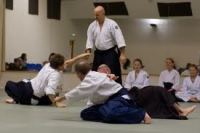Being an aikidoka, over the time, I have been fascinated by not only the fundamentality in the principles and application, but also to the great extent and relationships aikido shares with other grappling martial arts, mainly jujutsu, ninjutsu-taijutsu and sumo as the closest proximities because of the fellow Nihon-budo status. But what’s even more fascinating, from mingling from other martial arts practitioners, as well as reading literatures and watching from media, I found that jujutsu, the greater umbrella which aikido belongs to, also encompasses a lot of martial arts we even couldn’t think of. Jujutsu is so omnipresent in most of World’s traditional martial arts!
Omnipresent. Yes, personally speaking, I see that lots, if not most, of simple self-defense methods are heavily infested by jujutsu techniques, especially when dealing with weaponry or multiple attackers. Now if talking about grappling where jujutsu is often classified at, people from Brazilian Jiu-jitsu/Gracie Jiu-jitsu often argue that grappling is among the most natural and fundamental movements of human being, especially if talking about infancy movements developments and even pre-natal movements. This is quite analogous to what I hear from lots of doctors argue why swimming is the beat sport because of its fundamentality, where we all humans are literally swimming inside our mother’s womb.
I’d rather say that the rationale of the fundamentality of grappling is a very powerful foundation to suggest why jujutsu is so omnipresent. However, besides the inherence and fundamentality, then onmipresence of grappling movement, I also found that the eclecticness in jujutsu family martial arts is actually the another critical factor to contribute to jujutsu’s omnipresence. Whilst grappling become the mainframe of Jujutsu, hence to its, again, fundamentality and omnipresence, the elements of striking and weaponry are the ones that critically solidifies its frame. According to especially athletic experts, running aka athletics is the mother of all sports. Within this frame of rationale, striking and weaponry is also defined as “the mother of all martial arts”. Grappling, striking, and weaponry, in the eyes of Jujutsu, are like coffee, cream, and sugar. Together, these blend is called Jujutsu.
Let me go bit further about the importance of striking and weaponry inside Jujutsu. Striking makes Jujutsu more than just games or dances, like sumo or wrestling. It provides the sense of martial inside Jujutsu. Weaponry, on the other hands, aside from contributing to the martial aspects of jujutsu, also contributes to the aesthetic aspect of jujutsu, making it also an art. This proportional blend of grappling, striking, and weaponry is what makes jujutsu unique if compared to sumo, conventional boxing and wrestling, Greco-Roman wrestling, Pankrathon, and such. In my own Orientalist point of view, this unique blend is what makes jujutsu seem to be more “civilised” albeit still effective and efficient, if compared to these other kinds of wrestling.
Besides of the unique blend, the principles within jujutsu is the another one aspect that solidifies its omnipresence. In the jujutsuan principles, size, power, numbers should not be a problem for someone to overcome his/her opponent/s. Even a wiry, lame person should be able to defeat strong multiple attackers safe and sound. Therefore, from this fundamental principle, the necessity for efficient techniques are always fostered and reminded at all times. That’s why jujutsu masters often argue that because of this relevance, as a martial art, jujutsu is suitable for all kind of people, regardless of age, sex, creed, religion, culture, health, size, and body shape. Even the handicapped can be so adept in jujutsu family martial arts. This all proves how universal, fundamental, and omnipresent jujutsu is, in regarding its philosophy, fundamental, and technical status.
Last but not least, the modern history of jujutsu iteself also strongly reflects the reason for the omnipresence of jujutsu. By this case, objectively speaking, I really must give high credits for Kodokan Judo and its ancestor arts, as well as Kano Jigoro-Mifune Kyuzo as both the representative art and figure. During the last century, Kodokan Judo was greatly responsible in forming, as well as solidifying tons of modern martial arts system in this planet, especially in the European World. From the late 19th century, Kodokan Judo inspired Bartitsu, the martial arts we associate Sherlock Holmes with. Then in 20th century, our beloved brothers Vasili Oschepkov and Viktor Spiridonov from Russia then developed the martial art Sambo and Samoz martial arts. Even Krav Maga and its mother art Kapap, the famous self-defense system, is also heavily derived from Kodokan Judo-Jujutsu, albeit Imi Lichtenfeld as the founder of Krav Maga himself was a boxer-wrestler. Then, came the Brazilian Jiu-jitsu/Gracie Jiu-jitsu, the most famous jujutsu derived-art in the Western world. This interesting historical facts, again, showed how we, jujutsu practitioners of all over the world should feel and share the sense of familiarity with alot of different martial arts. Now it’s like everyone is connected, yes?
These are the factors, both intrinsic and extrinsic that contributes to the universality, fundamentality, then omnipresence of jujutsu. I don’t mean to hinder other kinds of arts, but based on these facts and arguments, this is what makes me proud as an aikidoka as part of the vast jujutsu family. I am an aikidoka, I am a jujutsuka, and I’m proud of it. But above all, we are all family! Tachi Rei!















